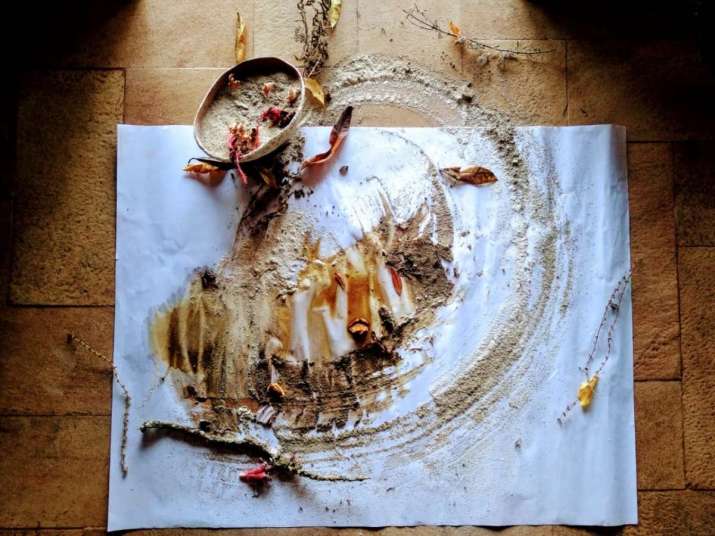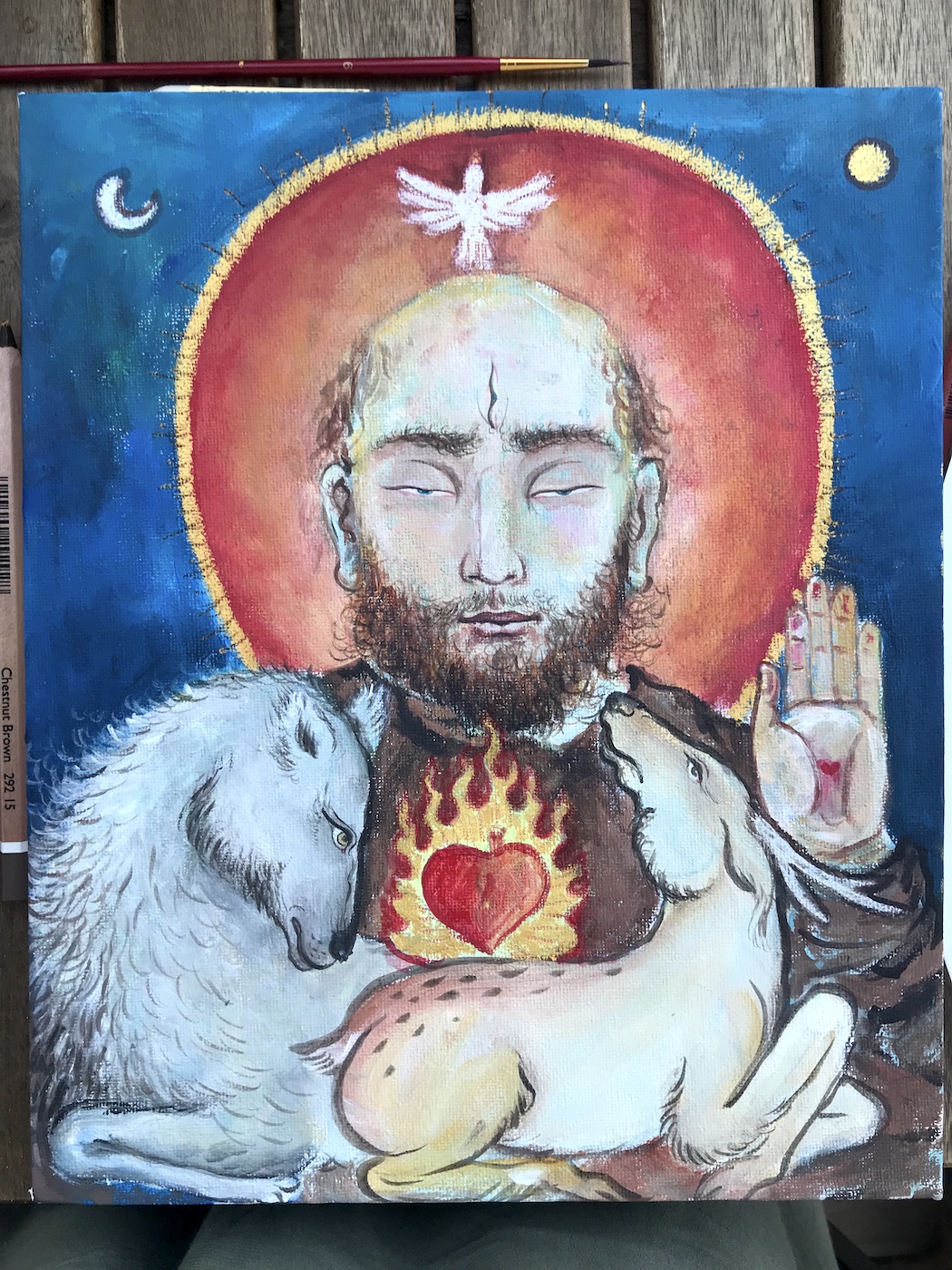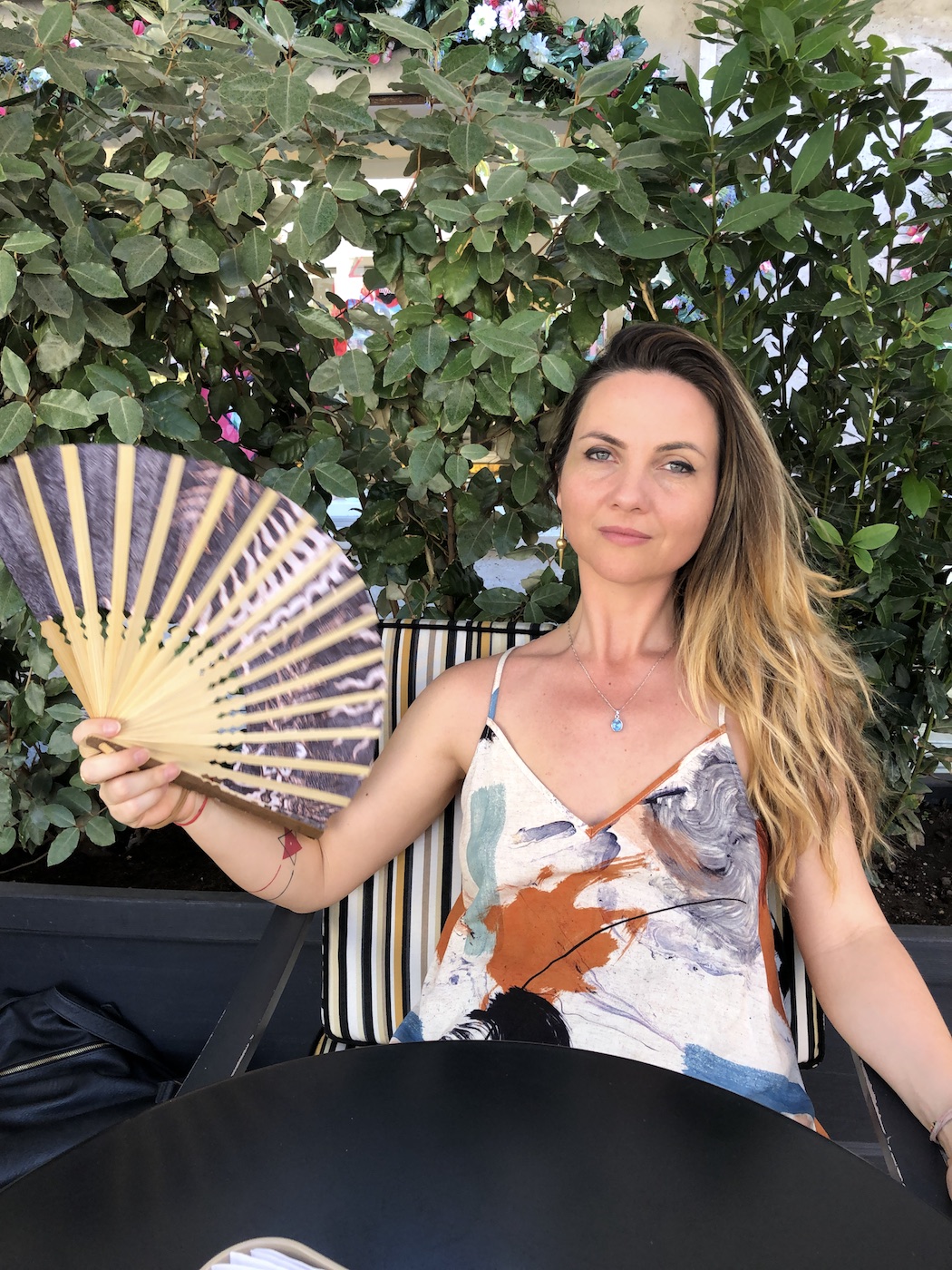FEATURES|COLUMNS|Geometry of Life
The Alchemist’s Bowl
 Art by Marilia Nigaru. Image courtesy of the author
Art by Marilia Nigaru. Image courtesy of the authorIn an allusion to the divine work of creation and the project of redemption contained therein, the social process was called in Latin “Magnum Opus” (Great Work). In this process an initial, mysterious, and chaotic matter, called raw material, in which opposites still irreconcilable in a violent conflict must be progressively transformed into a state of liberation and perfect harmony, the redemptive “Philosopher’s Stone” or the lapis philosophorum: «First, we combine, then we decompose, we dissolve the decomposed, we purify the divided, we add the purified and we solidify it. In this way, the man and the woman become one.» — Alexander Roob (translated from Portuguese)
I have maintained a habit of journaling since I was 12 years old. In particular, I wrote during difficult times, noticing how urgently I wanted to put my feelings down in writing in these moments. The comprehension that grew out of these moments might unfold at the moment of writing or many years later. Lately, I have been looking for clues in my diary from three years ago, and I found two sheets of paper glued into the middle of the book, as if I had hurriedly written in the urgency of the moment when I couldn’t find my diary. Then I was writing to my yidam, my tantric deity. I wrote about how tired I was of having a perfect life, of having a perfect husband who gave me a perfect home. How much I desired to explode the walls and run away with unknown gypsies. How much I wanted to be free with no thought for today or tomorrow, to meet other free souls and to eat with my hands. But fear of losing the man I loved and the stability that we could give my son made me stay. A part of me also felt ungrateful and guilty, but at the same time something untouched within me knew that this was my undeniable wild essence. I wasn’t tired of the man I loved deeply or of my son, but with the role of the wife and even the role of the mother. Somehow this was clear to me, but I didn’t have the wisdom to combine the call of my soul, which had the huge inconvenience of being indescribable, and the roles of the ego (I will call it ego, because I relate the ego to all the roles that come and go in this transitory life). And here I will call “soul” that awareness which is our deeper essence.
In July 2019, I convinced my husband to follow me in the footsteps of Saint Francis to visit Assisi in Italy. Even being a Buddhist, I’m sure that his soul attained nirvana. We were both reading his biographical novel, wonderfully written by Nikos Kazantzakis, during this pilgrimage. One paragraph of the book moved me deeply as much as it terrified me; about St. Francis talking with a sage and asking about the path to liberation. The exchange goes somethig like this:
The sage, beating his staff on the ground, said: “There is no way!”
Francis terrified replied: “What is there, then?”
“There is only the abyss. Jump!”
“Abyss? Is that the way? I can’t!”
“Then get married and forget your troubles.”
And so his skeleton-like arm motioned Francis to leave.

Saint Francis of Assisi. Image courtesy of the author
This is exactly how the Buddha taught in other words—at least I think so. This jump into the unknown. Emptiness . . . nothing else to explain. A dissolution of the roles, maybe becoming nobody . . . I don’t know. . . .
Have you ever had the feeling that you’ve witnessed something and there is no way back to not knowing or to ignoring? I could not ignore my soul’s yearning to run speedily against the abyss with open arms. It wanted to jump with open arms! I cried in that journey with a certain desperation, with a certain clairvoyance that I would lose everything that I most loved, but I also wasn’t sure whether that was it, or if I was simply going a bit mad. Although no longer resisting, I surrendered to the first step, which something within me thought was the worst thing I could do and yet thought that it was the best thing I could do, especially and specifically to be free from that fearful voice constantly screaming to choose the safest path. But then I did it: my long, full, and strong blonde hair that covered my back, I asked my man to shave it. Completely. Down to zero. And he did. We both cried. That moment contained a mix of joy, of fear; of excitement with the scent of a spiritual love bond and a rebellious freedom. This was my first step, and the next ones then came running.
Just a month later, back in Brazil, my man met another woman; ironically a TV actress who plays beautiful roles and consumed all his reason. He was rapidly consumed in an affair with her. Then he left. He also had a call and he followed it. He didn’t look back. By the end of the year, I had lost all that I had loved with that blind, sticky attachment of mine. Not only my hair, my feminine looks, my man, my house, but also all my deep, convictions and conceptions of love, sanctity, trust, partnership, stability, motherhood, conventional marriage . . . all of that ground to zero. Emptiness. Dead and still. Dark soot at the bottom of the alchemist’s bowl.
We chose different paths. We could have done so without so much pain if we were wiser . . . but now I think that the suffering is what the alchemists call mercury, and by collecting all inferior substances together they boil it and transform it into gold. While it is boiling and particles are being torn apart in the alchemist’s bowl, one feels death—it is death, it is painful. What is left, after quite some time . . . is this condensed little piece of something, totally purified, transformed, left only with the purest essence of what was originally made of—this seed of new life with a different kind of shine, of magnetism, of history. It had to be this way because it is the desire of the soul to undergo the alchemical process through the ego. Perhaps the ego is the bowl itself, where all things are boiled. This life is about the realization of the soul. The ego is the vehicle, the mask in the arena, the roleplayer, the myth, the symbol of the experience, which the soul guides with wrathful compassion. The ego, poor one, does everything it can to avoid and evade, but the ego is mortal and the soul has eternity, so it is more patient, it is wiser, it is stronger, and it is able to play.
Before. Image courtesy of the author
Is not that the soul has desire per se . . . like the waterfall, it doesn’t have any desire to fall from a cliff, it simply is. Somehow we incarnated in this limited body, we are the embodiment of dualism—this is human reality. By identifying with little roles in life we resist nature. We think it’s too much, too scary, too wild, too uncontrollable, but wise is creation . . . because by resisting it, it also creates energy, and motion, and life. This is the dance of the universe; expansion and contraction, tension and liberation, chaos and order—so all is in motion and so alive because of the mechanism of expansion and resistance!
So the soul and the ego have this cat-and-mouse play, if we see it as play. Or even as lovemaking between such duality, or cosmic intercourse as some call it (as in the Buddhist depiction of Samantabhadra). We would surrender to finally go through the alchemical process and be able to live the dance fully because we can, because it is our true potential. For my teacher in India, my drawings were never good enough and he insisted: “If you can express 100 per cent of your potential, why would I approve 50 per cent?” I can hear my Wild Heart saying the same to the role of the miserable woman with whom I sometimes identify myself. My Wild Heart says: “Stop being so small! You’re just missing it; it’s not about ‘her’—there’s something beyond the role you can experience: at the other side of ‘little me’ is actual freedom!” Yet freedom is not something we conquer or add to our lives . . . freedom is there when we renounce the importance of our roles, when we give up holding onto them so tightly. We could at some point just reverse the energy caused by pain (and we know how much energy there is!) and instead direct it toward our practice, to art, to service. What a breakthrough! What a blessing! This is called the alchemy of the soul, transforming soot into gold.
But let me tell you, the soul is deeply wise and doesn’t care about maintaining things as they are. It knows that the experience of love could go far beyond any mere attachments and ego delusions, especially attachment to all the roles to which we give our life energy—actually just at that moment, I realized that the most intimate yearning of the soul is the deepest fear of the ego. This is the true duality in which we all live.
As we entered pandemic isolation, I heard from many people about their experiences of the “house burning down,” which brought me to thinking and to writing about it here.

After. Image courtesy of the author
Just last week, a student of mine sent her report about an art installation that I had proposed she do, all about her own virtues and shadows. She made it very meaningful and spontaneous and I was very touched. She reported the actual process and then the secret process of the art piece as I had asked. In her secret report, she went back to her past as the piece had to do with time and death, and she remembered that when she was a teenager, very restless and immature, she had desired to change that “cage of consciousness” in which she no longer wanted to live; she wanted to grow up. So she drew in all the corners of her house a symbolic spiral as a reminder for her to simply change her consciousness. Exactly a week later, she found herself in a car crash that killed her friends and left her with numerous scars on her back and legs. I don’t have to tell you how much that changed her consciousness.
Now I am curious. How closely are we connected to the soul? I also like to call it the “wild heart” and I realize that my work with art and horses and the intuitive has always been a search to refine that voice, that gold. I’m just seeing that glimpse now because writing does that too. I wonder how much suffering actually has to do with the experience of the role and nothing else. The soul is kind of amoral. It is compassionate and guides us, but it is not corrupted by our cries and pleas. It swipes the sword, like Manjushri Buddha, so powerful and precise, emptying us of attachments, leaving space after those killing bombs within us, making us enter these cemeteries to which we are invited sometimes in a lifetime. There, only in that alchemical bowl of death and gold that we will never really understand at the ordinary level, is were we finally receive the dakini’s teachings. It is only then that we are able to fly because nothing holds us. In these moments we somehow even become less dense and everything becomes more possible and flexible, because her hair is gone, and the one who played the role of the beloved and the role of the tamed mother is gone, or is simply lighter and more translucent and maybe even more playful and fun. . . . Funnily enough, life continues to flow in its ordinary appearance with those transitory complex roles, but with a vast opening where the wild and fresh heart is able to shine and guide fearlessly. This is the heart of the Awakened Buddha. This is the One who also guides many of us, even 2,600 years after his role died. What is eternal still shines to the infinite.
Maybe I am totally wrong. Maybe there is no soul and no ego. Maybe we are all just a biological response to life. But then, by believing in what I have described here, I feel able to be a more conscious creator of my reality, especially after being boiled and distilled in the alchemist’s bowl. And from a ground covered by the soot of suffering, a nugget of gold cracks and the philosopher’s stone is revealed, leading the soul to a new stage of consciousness—the magnum opus, the immortality of the soul.
To celebrate the fire of transformation, I made a performance called Ciao 2020. Please enjoy it. I hope you can watch it until the end:
Tiffani Gyatso
Brasil
April 2021
Tiffani Gyatso is an artist from Brazil who has focused her field of study on the sacred expressions of art from different cultures. She specializes in traditional Tibetan thangka painting, which she learned in India at the Norbulingka Institute from 2003–06, before furthering her studies at the Prince School of Traditional Arts in London, where she studied Sacred Geometry of the Middle East. Today she runs her own art retreat center at the Atelier YabYum in the mountains of Brazil and guides art groups to India and Nepal.
References
Roob, Alexander. 1905. Alchemy and Mysticism. Köln: Taschen.
Kazantzakis, Nikos. 2012. Saint Francis. New York: Simon & Schuster.
See more
Related features from Buddhistdoor Global
The Proportions of Life
Remembering a Dance That Came in a Dream
Art, Culture, and Healing the World: A Conversation with Haema Sivanesan















